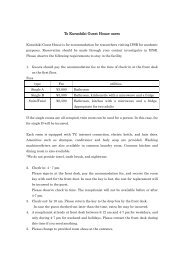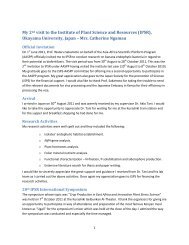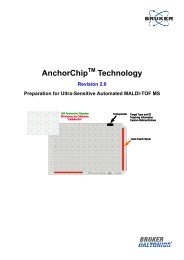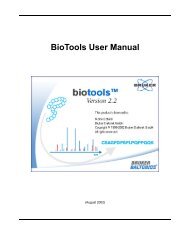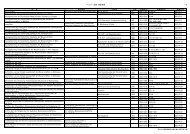Institute of Plant Science and Resources
Institute of Plant Science and Resources
Institute of Plant Science and Resources
Create successful ePaper yourself
Turn your PDF publications into a flip-book with our unique Google optimized e-Paper software.
Biotic Stress Unit<br />
Group <strong>of</strong> <strong>Plant</strong>-Insect Interactions<br />
Pr<strong>of</strong>essor<br />
Ivan Galis<br />
<strong>Plant</strong> defenses against insects evolved in a long term process <strong>of</strong> co-evolution <strong>of</strong> plants<br />
<strong>and</strong> herbivorous insects. In this process, plants developed enormous diversity in their<br />
chemical <strong>and</strong> mechanical defenses, <strong>and</strong> tuned regulation <strong>of</strong> defense mechanism to<br />
optimize the distribution <strong>of</strong> plant resources between defense <strong>and</strong> growth. Two main<br />
defense strategies <strong>of</strong> plants against insects involve direct <strong>and</strong> indirect defense<br />
mechanisms:<br />
(1) Direct defenses are based on the production <strong>of</strong> toxic chemicals that directly inhibit<br />
feeding <strong>of</strong> herbivores<br />
(2) During indirect defense, plants produce volatile compounds that attract natural<br />
enemies <strong>of</strong> herbivores that provide efficient protection to plants<br />
In the group, we focus on underst<strong>and</strong>ing <strong>of</strong> plant-herbivore interactions <strong>and</strong> induction <strong>of</strong><br />
direct <strong>and</strong> indirect defenses in plants at following levels:<br />
(A) Recognition <strong>of</strong> herbivore attack by plants <strong>and</strong> identification <strong>of</strong> herbivore-specific<br />
elicitors<br />
(B) Role <strong>and</strong> cross-talk <strong>of</strong> plant stress hormones in signal transduction <strong>of</strong> herbivoryrelated<br />
signals: jasmonic acid (JA) * ethylene *<br />
salicylic acid (SA) * abscisic acid (ABA)<br />
Herbivore<br />
elicitors Wounding<br />
(C) Transcriptional regulation <strong>of</strong> plant responses<br />
to herbivore attack <strong>and</strong> the role <strong>of</strong> transcription<br />
Ca 2+ , H 2 O 2<br />
factors (TFs) in defense<br />
(D) Identification <strong>of</strong> novel defense metabolites<br />
that mediate plant defense against herbivores<br />
including:<br />
• phenolic compounds<br />
• terpenoids<br />
• alkaloids<br />
• proteinase inhibitors (PIs)<br />
• green leaf volatiles (GLVs)<br />
• volatile organic compounds (VOCs)<br />
Ethylene<br />
ABA<br />
SA<br />
JAZ<br />
TFs<br />
MAP kinase<br />
signaling<br />
Jasmonic acid<br />
JA-Ile<br />
COI1<br />
JAZ<br />
TFs<br />
Herbivore attack induces burst <strong>of</strong> jasmonic acid<br />
which is converted to jasmonoyl-isoleucine<br />
(JA-Ile) that mediates COI1-dependent<br />
degradation <strong>of</strong> JAZ repressor proteins,<br />
transcriptional reprogramming <strong>and</strong><br />
activation <strong>of</strong> defense responses in plants.<br />
Direct defense<br />
metabolites<br />
Indirect<br />
defenses<br />
Predators<br />
parasitoids



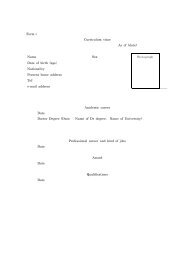
![[Application Forms to Tenure-track Assistant Professor] Applicants ...](https://img.yumpu.com/36047313/1/184x260/application-forms-to-tenure-track-assistant-professor-applicants-.jpg?quality=85)
